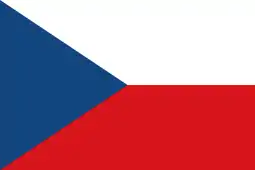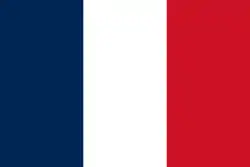Slaný
Slaný (Czech pronunciation: [ˈslaniː]; German: Schlan) is a town in Kladno District in the Central Bohemian Region of the Czech Republic. It has about 16,000 inhabitants. The town is part of the Prague metropolitan area. The historic town centre is well preserved and is protected by law as an urban monument zone.
Slaný | |
|---|---|
 Centre with the Church of Saint Gotthard | |
 Flag  Coat of arms | |
 Slaný Location in the Czech Republic | |
| Coordinates: 50°13′50″N 14°5′13″E | |
| Country | |
| Region | Central Bohemian |
| District | Kladno |
| First mentioned | 1262 |
| Government | |
| • Mayor | Martin Hrabánek |
| Area | |
| • Total | 35.12 km2 (13.56 sq mi) |
| Elevation | 234 m (768 ft) |
| Population (2021-01-01)[1] | |
| • Total | 16,010 |
| • Density | 460/km2 (1,200/sq mi) |
| Time zone | UTC+1 (CET) |
| • Summer (DST) | UTC+2 (CEST) |
| Postal codes | 273 79, 274 01 |
| Website | www |
Administrative parts
Villages of Blahotice, Dolín, Lotouš, Kvíc, Kvíček, Netovice, Otruby, Trpoměchy and Želevčice are administrative parts of Slaný.
Geography

Slaný is located about 25 kilometres (16 mi) northwest of Prague, in the geomorphological mesoregion of Prague Plateau. The Červený Creek flows through it from the southwest to the northeast. Its dominant feature is the Slánská Hill, 330 m (1,083 ft) above sea level.
History
The Wenceslaus Hajek's chronicle records Slaný as having been founded in 750, at the site of a salt spring below the Slánská Hill (slaný is a Czech word for "salty").[2]
The first written mention of Slaný is from 1262.[2] The town grew as a result of its location on the trade route between Prague and Saxony. The Benedictines established a hospital here in 1136, together with a church dedicated to St. Gotthard. It was this large presence of the church, and the unconsolidated state of landed property that went with it, that allowed King Wenceslaus II of Bohemia to charter Slaný as a town and give his royal assent to its Magdeburg rights only sometime in the decade after 1295.[2] In 1348, an earthquake damaged the now-fortified town; in 1371, a large fire broke out, and the church had to be rebuilt.
Slaný was captured by the Taborites in 1425 during the Hussite Wars, and remained in their hands until 1434. Not only did the Benedictine monks have to leave — this town by the hill was also one of Hussite holy cities, and their preachers expected it to survive the anticipated end of the world. Later, the Hussite king George of Poděbrady gave Slaný many privileges, after the town had supported his election to the throne. The town also participated in the Bohemian Revolt that opened the Thirty Years' War, housing the family of king Frederick V of the Palatinate. After the Battle of White Mountain, that meant a defeat for the cause, the town suffered as a result of the ravages of war. Afterwards, the new Catholic possessors of Slaný, the Martinic, erected many a baroque church and edifice that, together with a new monastery, adorn the town to this day.
Since the middle of the 19th century, Czech has been the dominant language there. Industrial development was delayed until around 1860. An important engineering factory was built in 1872 and more followed. A factory producing batteries was founded in 1918. The infrastructure and amenities of a modern town have been gradually added since the second half of the 19th century.
Demography
|
|
| ||||||||||||||||||||||||||||||||||||||||||||||||||||||
| Source: Historical lexicon of municipalities of the Czech Republic[3] | ||||||||||||||||||||||||||||||||||||||||||||||||||||||||
Transport
The town of Slaný is situated at the crossing of the Prague–Louny, Prague–Karlovy Vary roads. The Prague–Most railway, along with several bus lines, service the town.
Sights

- The town hall, symbol of the town (house from 1378, rebuilt after 1896 and in 1840)[4]
- The Trinitarian Church, built 1581–1602, a monastery built in 1655–1662[4]
- Former college of Piarists (built 1658, rebuilt 1877), today a museum[4]
- Gothic Church of St. Gothard (originally from the 13th century)[4]
- Renaissance houses[4]
Notable people
- Josef Matěj Navrátil (1798–1865), painter
- Václav Beneš Třebízský (1849–1884), priest and novelist; studied here
- Jan Malypetr (1873–1947), politician, prime minister of Czechoslovakia
- Oskar Fischer (1876–1942), psychiatrist and neuropathologist
- Olga Scheinpflugová (1902–1968), actress and author
- Karel Smyczek (born 1950), film director and screenwriter
- Eva Urbanová (born 1961), operatic soprano
- Martin Procházka (born 1972), ice hockey player
- Jiří Tlustý (born 1988), ice hockey player
Twin towns – sister cities
Friendly towns
Slaný also cooperates with:[2]
 Bolatice, Czech Republic
Bolatice, Czech Republic Guyancourt, France
Guyancourt, France Linlithgow, Scotland, United Kingdom
Linlithgow, Scotland, United Kingdom
Slaný is a part of the Commonwealth of Towns With Hussite Past and Tradition, along with other 11 Czech and 6 German municipalities.[5]
Gallery
.JPG.webp)
References
- "Population of Municipalities – 1 January 2021". Czech Statistical Office. 2021-04-30.
- "O Slaném" (in Czech). Město Slaný. Retrieved 2020-12-08.
- "Historický lexikon obcí České republiky 1869–2011 – Okres Kladno" (in Czech). Czech Statistical Office. 2015-12-21. pp. 7–8.
- Historical monuments of the town of Slaný
- "Města" (in Czech). Společenství měst s husitskou minulostí a tradicí. Retrieved 2020-12-08.
Bibliography
- Kubánek, Vladimír (2010). Královské město Slaný na pozadí historie (in Czech). Brno.
- Dobner, Libor (2016). Slaný - kapitoly z historie královského města (in Czech). Slaný: Roman Kabátek, Jiří Linke.
- Lacina, Josef (1885). Paměti královského města Slaného, I. Za svobody i v porobě (in Czech). Slaný.
External links
| Wikimedia Commons has media related to Slaný. |
- Official website
- History of the town (in English)
- Museum of Slaný (in Czech)
- Culture life in Slaný (in Czech)
- Slany - travel guide (basic facts, history, sights, day trips)
- Chisholm, Hugh, ed. (1911). . Encyclopædia Britannica. Vol. 24 (11th ed.). Cambridge University Press.
- Slaný on the map